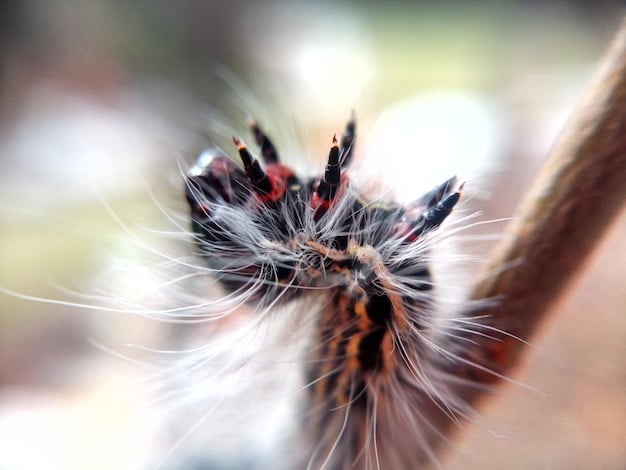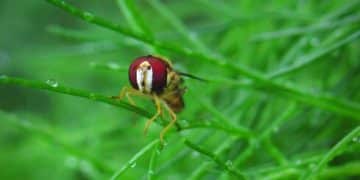The Ultimate Guide: Flea and Tick Prevention for Pets This Summer

The Ultimate Guide to Preventing and Treating Fleas and Ticks on Your Pet This Summer offers comprehensive strategies, including identifying symptoms, selecting appropriate treatments, and implementing preventative measures, to safeguard your pet’s health and comfort during the warmer months.
Summer is a wonderful time for pets to enjoy the outdoors, but it also marks the peak season for fleas and ticks. These pesky parasites can cause significant discomfort and transmit diseases to your beloved animals. This The Ultimate Guide to Preventing and Treating Fleas and Ticks on Your Pet This Summer aims to provide you with all the necessary information to protect your furry friends and keep them healthy all season long.
Understanding Fleas and Ticks: A Pet Owner’s Primer
Before diving into prevention and treatment, it’s essential to understand the enemy. Fleas and ticks are different parasites with varying life cycles and health risks. Knowing the basics can help you better protect your pet.
Flea Facts
Fleas are small, wingless insects that feed on blood. They can jump impressive distances and reproduce rapidly, leading to infestations in your home and on your pet.
Tick Talk
Ticks are arachnids (related to spiders) that also feed on blood. They attach themselves to hosts and can transmit diseases like Lyme disease and Rocky Mountain spotted fever.
- Life Cycle Differences: Fleas have a complex life cycle with eggs, larvae, pupae, and adult stages, while ticks have a simpler life cycle with larvae, nymphs, and adults.
- Disease Transmission: Ticks are more notorious for transmitting diseases compared to fleas, although fleas can transmit tapeworms.
- Habitat Preferences: Fleas thrive in warm, humid environments, while ticks are found in wooded and grassy areas.

By recognizing the differences, you’ll be better equipped to identify and manage these pests effectively, ensuring a happier and healthier summer for your pet.
Identifying Flea and Tick Infestations: Know the Signs
Early detection is crucial when dealing with fleas and ticks. Recognizing the signs of an infestation allows you to take prompt action and prevent further complications.
Flea Symptoms
Fleas often cause intense itching and scratching, leading to skin irritation and potential secondary infections.
Tick Symptoms
Ticks are often visible as small bumps on your pet’s skin. In some cases, you might also notice signs of Lyme disease or other tick-borne illnesses.
- Excessive Scratching and Biting: Pets with fleas will often scratch, bite, or lick themselves excessively, especially around their hindquarters.
- Visible Fleas or Tick: Adult fleas are small, dark, and move quickly. Ticks appear as small, round bumps that can range in size.
- Hair Loss and Skin Irritation: Flea bites can cause allergic reactions, leading to hair loss, redness, and inflammation.
If you observe any of these signs, it’s important to inspect your pet thoroughly and consult with your veterinarian for appropriate treatment options.
Preventative Measures: Keeping Fleas and Ticks Away
Prevention is always better than cure. Implementing preventative measures can significantly reduce the risk of flea and tick infestations. It involves creating a pest-unfriendly environment and utilizing preventive products.
Environmental Control
Maintaining a clean environment both indoors and outdoors can help minimize flea and tick populations.
Preventive Products
Various products, including topical treatments, oral medications, and collars, can help prevent flea and tick infestations.

- Regular Grooming: Frequent brushing can help remove fleas and ticks, as well as their eggs, from your pet’s fur.
- Yard Maintenance: Keep your lawn mowed, remove leaf litter, and trim shrubs to reduce tick habitats.
- Veterinarian-Recommended Products: Consult your vet to choose the most effective and safe flea and tick prevention products for your pet.
By combining environmental control with preventative products, you can establish a strong defense against these pests, keeping your pet safe and comfortable.
Choosing the Right Treatment: Options for Your Pet
If your pet has already fallen victim to fleas or ticks, selecting the appropriate treatment is essential. Options range from over-the-counter remedies to prescription medications, each with its own advantages and considerations.
Topical Treatments
Topical treatments are applied directly to your pet’s skin and can kill fleas and ticks on contact.
Oral Medications
Oral medications are ingested and work systemically to eliminate fleas and ticks.
When selecting a treatment, consider your pet’s species, age, health status, and lifestyle. Always follow the instructions carefully and consult with your veterinarian before starting any new treatment.
Natural Remedies: Exploring Alternative Options
For pet owners seeking natural alternatives, several remedies can help repel or eliminate fleas and ticks. While these options may be less potent than conventional treatments, they can be a useful addition to your pest management strategy.
Essential Oils
Certain essential oils, like lavender and cedarwood, are known for their repellent properties.
Diatomaceous Earth
Diatomaceous earth is a natural powder that can dehydrate and kill fleas and ticks.
However, it’s crucial to use these remedies safely and under the guidance of a veterinarian, as some may be toxic to pets if ingested or applied incorrectly.
Home Care Strategies: Removing Fleas and Ticks from Your Living Space
Eliminating fleas and ticks from your pet is only half the battle. You also need to address infestations in your home and yard to prevent re-infestation. Effective home care strategies can help create a pest-free environment.
Indoor Cleaning
Thoroughly cleaning your home can remove fleas and ticks from carpets, upholstery, and bedding.
Outdoor Measures
Treating your yard with insecticides and maintaining landscaping can reduce tick populations.
- Vacuuming Regularly: Vacuum carpets, rugs, and upholstery frequently to remove fleas, ticks, and their eggs.
- Washing Bedding: Wash pet bedding, as well as your own bedding, in hot water to kill any remaining pests.
- Professional Pest Control: Consider hiring a professional pest control service for severe infestations or if you’re struggling to manage the problem on your own.
Taking the time to implement these strategies will create a more comfortable and pest-free environment for both you and your pet.
| Key Point | Brief Description |
|---|---|
| 🐶 Identification | Recognize flea and tick symptoms early for effective treatment. |
| 🛡️ Prevention | Use vet-recommended products and maintain a clean environment. |
| 🌿 Natural | Explore natural remedies with veterinary guidance. |
| 🏠 Home Care | Clean your home and yard to prevent re-infestation. |
Frequently Asked Questions
▼
Bathing your pet every 1-2 weeks can help remove fleas. Use a vet-approved flea shampoo for best results. Regular bathing also helps to keep their coat clean and healthy.
▼
Flea and tick collars can be effective but may not be suitable for all pets, especially those with sensitive skin. Consult with your vet to determine the best and safest option for your pet.
▼
Yes, fleas and ticks can transmit diseases to humans. Ticks are known to transmit Lyme disease, while fleas can transmit diseases like bubonic plague, though rare. Protect yourself and your pets.
▼
Signs of tick-borne illnesses in pets include fever, lethargy, lameness, and loss of appetite. If you notice these symptoms, seek veterinary care immediately as early treatment improves outcomes dramatically.
▼
Keep your lawn mowed, remove leaf litter, and trim shrubs to reduce tick habitats. Create a gravel or wood chip barrier between your lawn and wooded areas to further deter ticks year round.
Conclusion
Protecting your pet from fleas and ticks this summer requires a multifaceted approach, including understanding these pests, implementing preventive measures, and choosing appropriate treatments. By staying vigilant and working closely with your veterinarian, you can ensure a happy and healthy summer for your furry friend.





